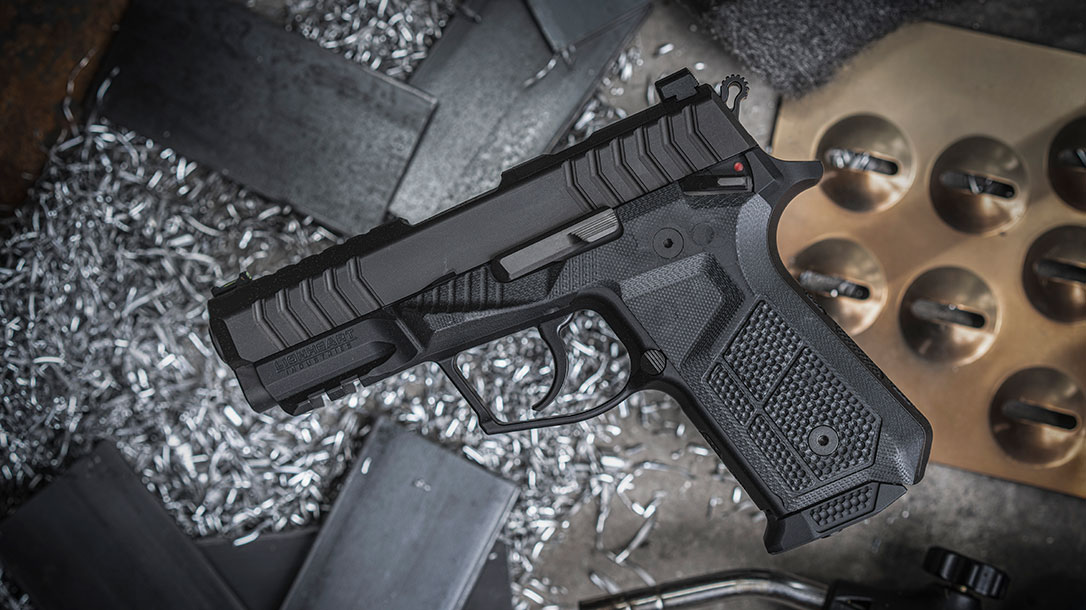A common question in firearms design is, “Why reinvent the wheel?” Many of today’s popular handguns are based on previous successful pistol models. For example, look at all the clones based on the Glock, CZ 75, or Beretta Model 92 Series. And when Lionheart Industries released its Vulcan 9 there was something very familiar about it as well.
Pedigree of the Lionheart Industries Vulcan 9
Daewoo Precision Industry Ltd. patented a pistol in 1992 that became the K5/DP-51. SNT Motiv of South Korea produced it. Several companies marketed the K5/DP51 in the United States in the 1990s.
In 2011, it was reintroduced in America through a collaboration between Daewoo/SNT Motiv and Lionheart Industries as the LH9 Series. In 2016, Lionheart introduced a variant in 9mm Luger called the Regulus. It was not an import but was, instead, made in the USA.
Advertisement — Continue Reading Below
This was when I first caught wind of this interesting pistol. The Regulus underwent several design, aesthetic, and cosmetic changes and evolved into what Lionheart is today calling the Vulcan 9.
There are four versions: the Ember, Shadow, Combat, and Anode; my test gun was an Anode.
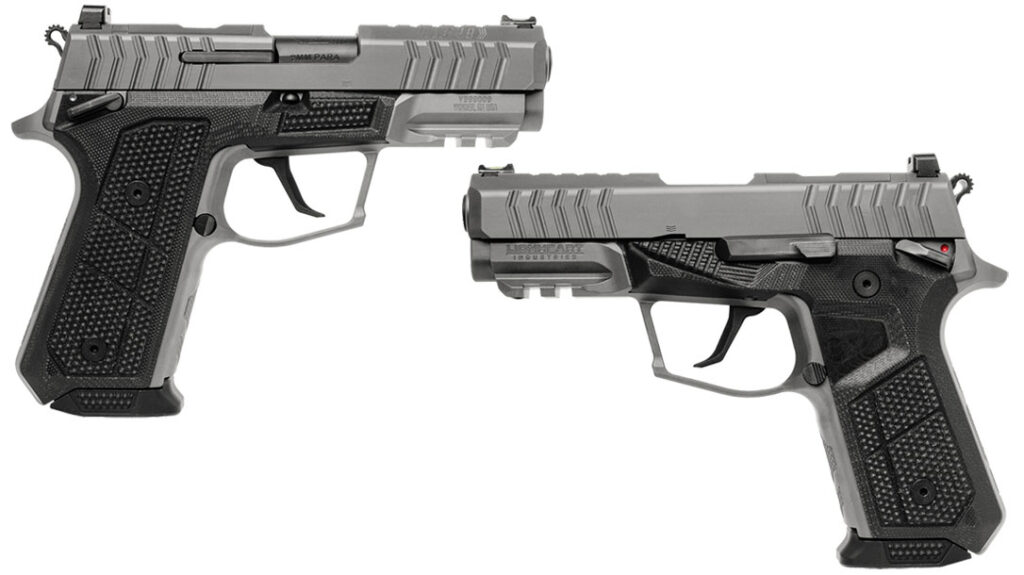
Advertisement — Continue Reading Below
Introducing the Lionheart Vulcan 9
At the heart of the new Vulcan 9 is the unique “Fast Action” trigger mechanism. Some refer to it as a Double Action (DA) Plus. To activate this feature, the hammer must be manually cocked, then simply pushed forward, back into the “relaxed” position. Now, the trigger is pressed to the rear, which re-cocks the hammer, and further pressure on the trigger fires the pistol.
With the “Fast Action” engaged, it takes only about 2 pounds of compression to move the trigger back about 0.50 inches until it “catches.” Then 3-4 more pounds of exertion drops the hammer.
The Vulcan 9 can also be fired in the conventional DA mode for the first shot. The DA pull is smooth, with a pull weight of 10-12 pounds. As with most hammer-fired DA pistols, after the first shot, the remaining shots are fired in single action.
Advertisement — Continue Reading Below
You also have the option of carrying the Vulcan 9 in Condition One or “cocked and locked” by cocking the hammer and applying the ambidextrous manual thumb safety.
The Rapid Engagement Grip System (REGS)
Another important feature of the Vulcan 9 is called the REGS or Rapid Engagement Grip System. An extension of the left G10 “Accelerator” grip panel over the trigger area forms a thumb rest that allows the shooter to exert downward pressure on the frame. This helps to better control muzzle flip.
I found that this system works even better when the support hand’s index finger is wrapped around the square-fronted trigger guard.
Advertisement — Continue Reading Below
Per the owner’s manual, a grip panel with the thumb shelf on the right side can be had for lefties. On the opposite grip panel above the trigger is a checkered panel where the shooter can place the index finger until ready to fire.
The black grips are checkered and add little to the width of the pistol, which measures 1.19 inches. There are also checkered panels on the front and backstraps of the 7075 aluminum frame.
Getting the Vulcan 9 On Target
The slide is machined from 4140 alloy steel, and both it and the frame are given a PVD Smoke Grey finish. It has deep chevron-shaped serrations front and rear.
Advertisement — Continue Reading Below
My test gun came with a green fiber-optic front sight and a rear sight that is serrated in the rear to reduce glare. The rear sight also slopes forward at the front to facilitate catching the trouser belt for one-handed, emergency slide retraction. Both sights are standard height and mounted in SIG P365 dovetail cuts, allowing lateral movement for windage adjustment. Tritium night sights are optional.
The Vulcan 9 slide is also optics-ready, with a cover plate in place. No adapter plates are needed, and the screw pattern accommodates dot sights with the Shield RMSc or Trijicon RMRcc footprints.

Advertisement — Continue Reading Below
The Tru-Axis barrel length is 3.7 inches, with a threaded 4.3-inch barrel as an option. It’s made of 416R stainless-steel and is black DLC coated.
My test gun came with the standard, smooth-faced trigger, that’s just over 0.25 inches wide. On some Vulcan 9 models, you can get a “J” Trigger Shoe that is more flat-faced and allows for more consistent trigger finger placement to enhance accuracy. Similarly, the hammer has a loop-style spur and is serrated for good thumb purchase.
Rounding Out the Gun’s Package
Other frame features include a dust cover with integral Picatinny rail, plus a low-profile slide stop and magazine catch. The manual safety levers are rather small and pivot at the front. When in the up position, it is “on-safe,” and the down position exposes a red dot and makes the pistol ready to fire.
Advertisement — Continue Reading Below
The Vulcan 9 is furnished with two 15-round magazines; one of my magazines had a “Multitool Baseplate.” Inset into the bottom is a NANO2 Multitasker tool that can be used to remove the grip screws. It is held in place by the magazine spring seat button. The Regulus magazines are an in-house product.

My test gun came in a tan, ballistic nylon case with a zipper closure and carrying handles. Inside was a zippered compartment for the Vulcan 9, pouches for the optics hardware, and a very detailed owner’s manual.
Advertisement — Continue Reading Below
Segmented elastic bands held an extra magazine, a cleaning kit, a bottle of SLIP 2000 Extreme Weapons Lubricant, and a safety padlock. This is a very nice setup that befits its price point.
The disassembly process for cleaning is simple and straightforward. It is covered in the manual, so I won’t discuss it here. Fit and finish of the Vulcan 9 are first-rate, with no machine marks or blemishes on the pistol’s exterior.
Prepping the Pistol for Testing & Evaluation
My ammunition locker was getting pretty low on 9mm loads, so I mixed some vintage and contemporary cartridges. For general shooting, I selected Black Hills Factory New 115 gr. FMJ rounds. Then I grabbed a box of Federal Tactical (LE) 147 gr. JHP’s that feature the Hydra-Shok bullet.
Next up are some recent Norma MHP loads with a 108 gr. monolithic hollow-point bullet. Another recent load I picked was Nosler ASP (Assured Stopping Power) cartridges with a 115 gr. JHP. Lastly, were some vintage Winchester LE loads with a 127 gr. SXT (Black Rhino) HP bullet at +P+ velocities.
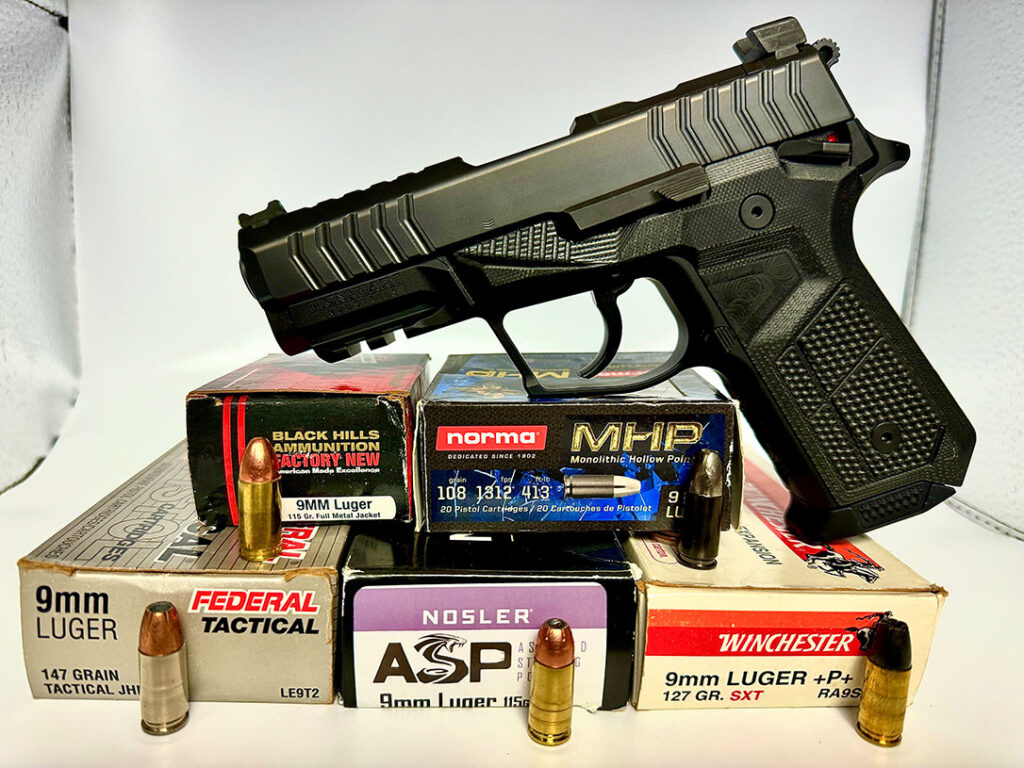
For packing leather, I chose a three-piece rig from El Paso Saddlery. For the holster, I went with a #88 “Street Combat” shuck. It’s a pancake style, open top/open muzzle, high-ride, made of premium saddle leather, with a suede lining that helps with retention. Mine is in russet brown, with fish scale stamping and 1.5-inch width belt loops.
I mated it with a 1F Friction Single Mag pouch. It’s also open top, has a snap-closure belt loop, and is the same color and finish as the holster.
Mated with the holster and pouch was a #100 New Ranger pants belt that’s 1.5 inches wide and billeted for handgun carry or dress wear. It is smooth leather lined, with a brass buckle, and in the same color and stamping as the other leather items.
A very practical, yet classic-looking outfit indeed.
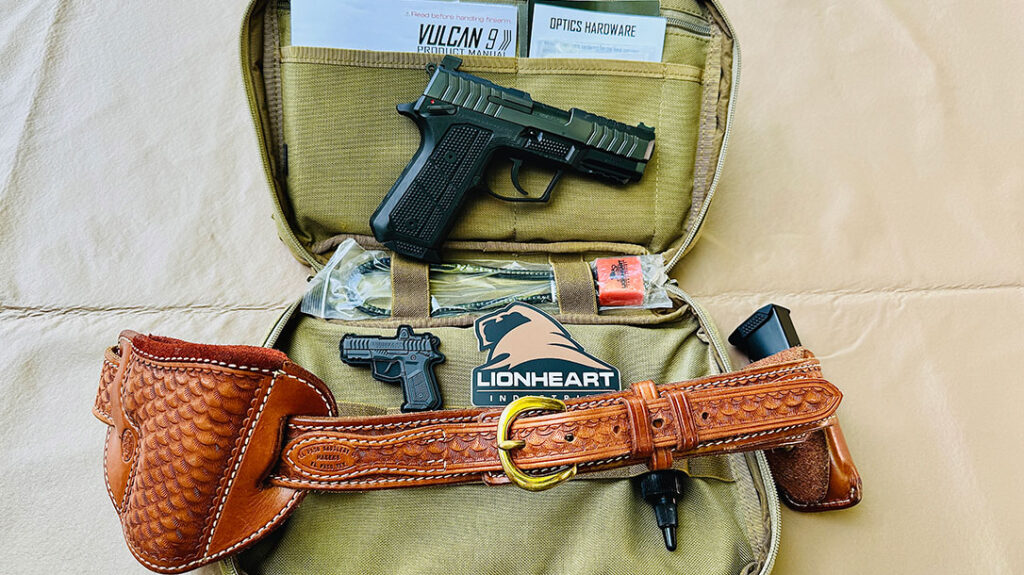
Running the Vulcan in Its Stock Configuration
For my test and evaluation, I decided not to hang anything on the Vulcan 9 Anode. The factory iron sights will not co-witness with my Burris Fastfire C MRDS. I’m not comfortable with an electronic sight that wouldn’t allow an iron sight backup.
You can find SIG P365 suppressor height sights that will work with the Vulcan 9. But I wasn’t going to swap out the iron sights on a test gun.
I also elected not to use a tactical light on the Picatinny rail. If I had, it would have been a quick attachable/detachable type, like the Safariland Rapid Light System Model RLS13PIC1.
Hitting the Range
Due to weather conditions, I decided to do my accuracy evaluation indoors and my chronographing and combat shooting test outdoors. I took the gun and gear to a local Range USA facility where I’m a member.
Once there, I set up on my assigned lane, which has a tabletop for my sandbag rest. I used multi-bullseye paper targets that were sent down to the 15-yard line. All shooting with the Vulcan 9 was done in single-action mode, with three 5-shot groups per load.
Of the five 9mm test loads, the most accurate proved to be the old Federal Tactical with the 147 gr. Hydra-Shok JHP. One 5-shot cluster measured 2.12 inches, and the 3-group average was 2.33 inches.
None of the group averages went over the 2.87-inch mark, and the point of aim/point of impact was good. A few groups moved off right of center. The rest of the group data is in the accompanying performance table (below).
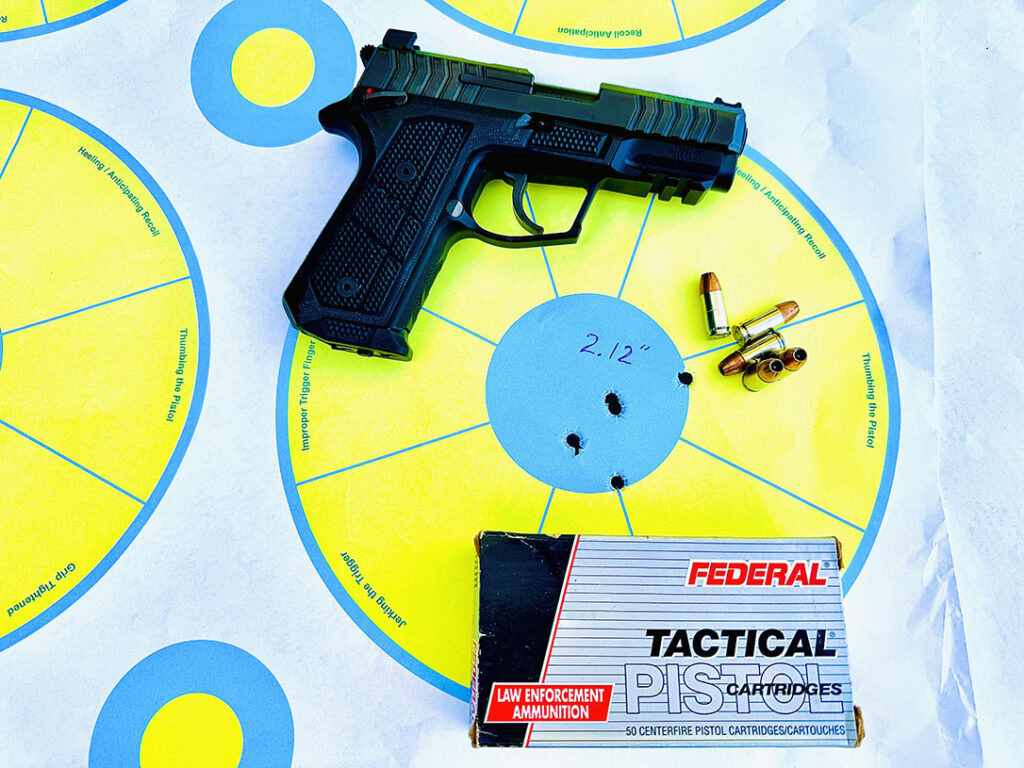
Drilling Paper
Outdoors, I set up my Oehler Model 35P chronograph before the wind kicked up and got my velocity readings on the 9mm test loads through the 3.7-inch Tru-Axis barrel. This data is also included in the performance table (below).
For the practical/combat shooting evaluation, I erected my target stand at 15 yards and attached a Thompson Target B27 STOP target with immobilization zones. The red zones score 10 points, and the other zones are worth 5 points.
In the hand of the skeletal “bad guy” is a DA revolver. I loaded up my two 15-round magazines with a mix of the test ammunition. Then I inserted one in the Vulcan 9 and the other in the EP Saddlery 1F mag pouch worn on my left side at about 9 o’clock. The Street Combat holster was worn at 3 o’clock on my right side.
Before holstering, I chambered a round and placed the Vulcan 9 in the “Fast Fire” mode. I repeated this at the beginning of each stage.
Then, I moved up to within 3 yards of the target and drew the Vulcan 9 from the holster. After taking a step to the right, I engaged the threat with six rounds, shooting in an instinctive/close-quarters manner, using my strong hand only.
I then transitioned the pistol to my support hand and fired six more shots in like manner. After a 360° assessment, I slowly worked the gun back into the holster. This was repeated at the end of each stage.
Running the Vulcan 9 for Self-Defense
Next, I backed up to 7 yards, drew the Vulcan 9, and assumed an isosceles two-handed stance. I then engaged the target using the sights and fired a double-tap. The pistol was lowered to “high-ready,” and I re-engaged the target with one shot, a rapid reload, and a follow-up shot. Another double-tap from high-ready followed this.
Remaining at 7 yards, I drew and fired two shots center-mass and one shot to the head for a “failure” or body armor drill. This was repeated a second time.
Afterward, I repaired to the 15-yard line and, using an impromptu barricade, shot two rounds from the left side and two rounds from the right side, both standing. Then, from a covered kneeling position, I fired my last two shots.
Of a possible 300 points, I scored 265. One of my headshots was completely outside the scoring zones (sigh).
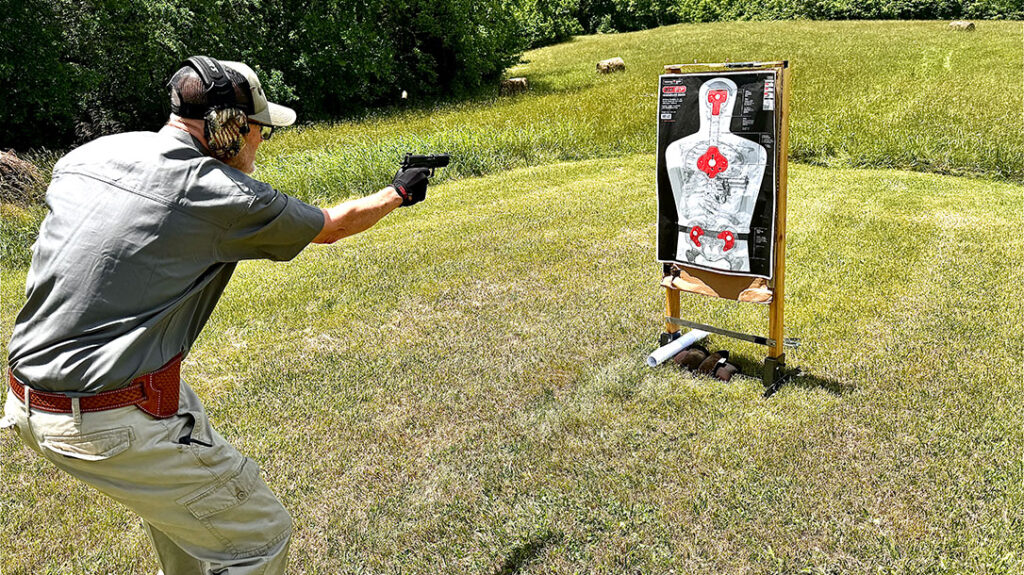
The Rest of the Story
At the indoor range, I took some sighting shots with Vulcan 9 and did some rapid-fire shooting. This was just to check out the pistol’s reliability. That, added to the formal test shooting, amounted to some 175 shots. I didn’t have a single malfunction.
No shooting was done starting from Condition One. The thumb safety levers are smallish but easily manipulated into the “safe” position. I just didn’t feel the need.
What Lionheart calls their golf ball-type texturing on the grip panels and grip frame allowed a good hold on the pistol and didn’t prove abrasive to the hand. Between that texturing and the Rapid Engagement Grip System, rapid repeat shots were effortlessly controllable. Even with the hot Winchester LE-Only +P+ loads.
The magazine catch was easy to manipulate, and empty magazines dropped right out when it was pressed. This pistol pointed very naturally for me due to the grip angle and flat profile backstrap. The “Fast Action” trigger took some getting used to, but it is a worthwhile feature and assisted in practical accuracy.
It took me almost two years to get a test gun from Lionheart, but I believe it was worth the wait. I’d ride the river with this pistola.
For more information, please visit LionheartIndustries.com.
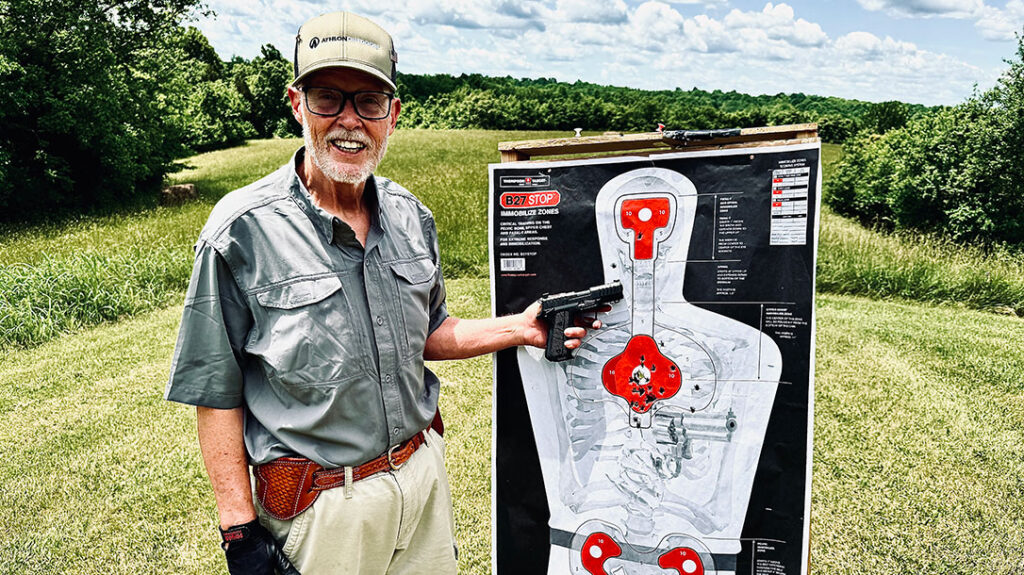
Lionheart Industries Vulcan 9 Specs
| Mechanism | Fast Action DA/SA Trigger, Browning Tilt lock-up |
| Caliber | 9mm Luger |
| Capacity | 15+1 cartridges |
| Barrel | 3.7 in. stainless steel |
| Overall Length | 6.9 in. |
| Empty Weight | 28 0z. |
| Sights | Fiber-optic front, fixed square-notch rear; optics ready slide |
| Finish | PVD Smoke Grey |
| Stocks | Black, textured G10 |
| MSRP | $1,599.00 |
Performance
| Cartridge | Ave. Velocity | Best Group | Average Group |
| Black Hills Factory New 115 gr. RN-FMJ | 1102 FPS | 2.23” | 2.87” |
| Federal Tactical 147 gr. Hydra-Shok JHP | 870 FPS | 2.12” | 2.33” |
| Norma MHP 108 gr. Monolitic HP | 1086 FPS | 2.29” | 2.83” |
| Nosler Assured Stopping Power 115 gr. JHP | 1049 FPS | 2.60” | 2.92” |
| Winchester LE 127 gr. SXT-HP +P+ | 1209 FPS | 2.24” | 2.53” |
NOTE: Bullet weight measured in grains, velocity in feet per second 10 ft. from the muzzle by an Oehler Model 35P chronograph, and accuracy in inches for three 5-shot groups at 15 yards.
